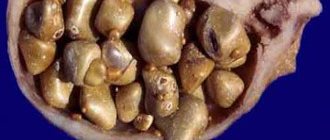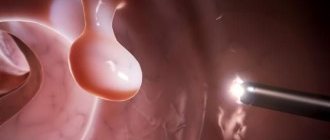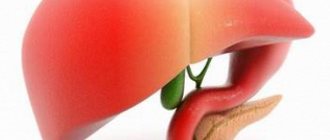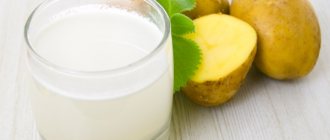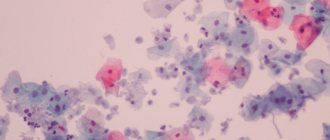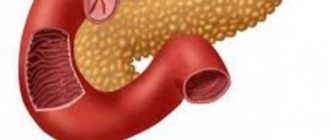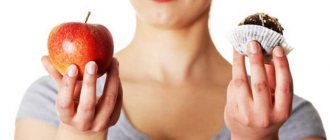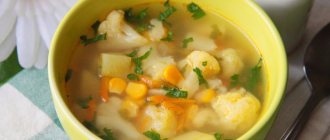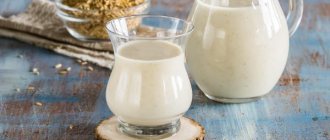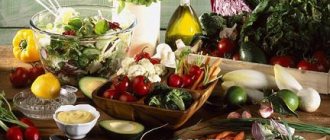Gallstone disease (GSD) is a fairly common disease of the gastrointestinal tract. Characterized by the formation of stones in the gallbladder or ducts. According to statistics, gallstone disease occurs several times more often in women than in men.
Bile, produced in the liver, accumulates in the gallbladder, then enters the intestines through the bile ducts, participating in the digestion of food. When the balance of bile components in the liquid is disturbed, solid flakes form, which, when compacted, turn into stones. The stone, getting into the ducts, clogs the hole, causing an acute attack.
The appearance of stones is most often influenced by the following factors:
- Non-compliance with diet, excessive overeating or fasting.
- Sedentary lifestyle, sedentary work.
- Metabolic disorder leading to excess weight.
- Pregnancy.
- Diseases of the gallbladder, liver, and other organs of the digestive system.
- Diabetes.
Treatment must be started immediately to prevent deterioration of the patient's condition, leading to complications, including death.
General rules
Gallstone disease is considered a dysmetabolic disease in which stones form in the gall bladder due to impaired cholesterol or bilirubin .
Stones can be cholesterol, pigment (or bilirubin), calcium and mixed. Cholesterol and black pigmented ones are formed more often in the bladder, and brown ones - in the ducts. The reason for their formation is excessive saturation of bile with sediment. In the gallbladder, the process of bile thickening constantly occurs, and it becomes more saturated with cholesterol.
The formation of stones is a dynamic process and the loss of crystals alternates with their dissolution, albeit partial. The amount of poorly soluble cholesterol in the formed stone constantly increases, and it increases in size. The growth of stones per year varies from 1 to 4 mm; new ones form in only 14% of patients.
predisposition , defects in the synthesis of solubilizers, geographic place of residence, obesity , cirrhosis of the liver , pregnancy , diabetes mellitus , bile stasis in the bladder, and dyslipoproteinemia in the occurrence of cholesterol cholelithiasis. A certain place is occupied by improper nutrition: an excess of carbohydrates and proteins of animal origin in the diet, a lack of plant fibers and plant proteins.
In the initial stages of the disease, ultrasound may reveal thick bile oversaturated with cholesterol ( biliary sludge ) for several years - this is a period of disturbances in its physicochemical properties. There are no clinical manifestations of the disease and this time is most favorable for conservative treatment (reducing the lithogenicity of bile and normalizing bile secretion).
If changes in the chemical composition of bile are not eliminated, and inflammation of the mucous membrane and hypomotor dysfunction of the bladder occur, the formation of microliths up to 5 mm begins. This period also occurs without clinical manifestations. chenotherapy is effective .
The microlites then coalesce to form macrolites larger than 5 mm. Inflammation and impaired motility of the gallbladder worsens. Some nonspecific symptoms are already appearing: aching pain, bitterness in the mouth, heaviness in the right hypochondrium that occurs when there is an error in diet, a tendency to flatulence , frequent diarrhea and constipation . During an attack, sharp, unbearable pain occurs suddenly, radiates to the right arm and shoulder blade, and is accompanied by nausea and repeated vomiting, which does not bring relief. An attack is provoked by drinking alcohol and eating fatty foods, shaking, driving, psycho-emotional stress or carrying heavy objects.
If macroliths are detected, patients are offered lithotripsy (crushing in the presence of single and few stones) or contact dissolution of stones (contact litholysis). With this method, a solvent is injected into the bladder or ducts. Only cholesterol stones of any size dissolve. For the procedure, methyl tert-butyl in the presence of stones in the bladder and propionate in the bile ducts.
Gallstones
As already noted, eating foods high in cholesterol, fats and refined carbohydrates, a disordered diet and an unbalanced diet affect the process of stone formation. For symptoms of cholelithiasis, treatment with diet is necessary at all stages of the disease. As mentioned above, in the early stages of biliary sludge, the composition of bile can be completely adjusted and the formation of stones can be prevented. At the stage of microliths, nutrition and the use of drugs can change the composition of bile and dissolve them, and if stones have formed, they can stabilize their growth and prevent exacerbations (biliary colic).
Let's figure out what diet can be prescribed for gallstone disease? The basic diet is Table No. 5 and its variations depending on the stage of the disease. Of course, if you have gallstone disease, you should not eat foods containing cholesterol and it is recommended to enrich your diet with plant fiber. Cholesterol stones are found in people who overeat, abuse animal fats, fatty meats, eggs and caviar. Spicy and fatty foods, egg yolks are also excluded, and in case of poor tolerance, vegetable oils are limited, which have a pronounced choleretic effect and can provoke an attack of cholelithiasis of the gallbladder.
Diet treatment for gallstones includes:
- Limit fat to 80 g (75% animal, 25% vegetable).
- Increased dietary fiber (from vegetables and fruits).
- Increasing the content of products with magnesium salts.
- To eliminate bile stagnation, eat up to 6 times a day.
- It is not recommended to drink alcoholic beverages (even in “small” quantities).
- Weight gain should not be allowed. With concomitant obesity, the energy value of the diet should be reduced by limiting the amount of fat (70 g) and carbohydrates (250-300 g). Weight loss has a beneficial effect on the course of gallstone disease.
- Lithogenicity of bile is eliminated by long-term use of chenodeoxycholic acid and ursodeoxycholic acid (at least 6 months).
At the first stage of the disease, there are no prohibited foods, but it is necessary to follow a diet, since eating at a certain time stimulates the secretion of bile and the motor function of the bladder.
Outside of an exacerbation, moderate sparing of the gallbladder and liver is necessary, normalization of bile secretion function and cholesterol levels, which ensures the diet of the basic Table No. 5 . This is a physiologically complete diet, which includes split meals that promote the regular outflow of bile. The calorie content of the diet is 2400-2600 kcal (proteins - 80 g, fats - 80 g, carbohydrates - 400 g).
Limit the consumption of salt (10 g), fats (especially refractory ones), liquid within 1.5-2 liters. Dishes are prepared boiled, steamed, and baking without crust is allowed. Vegetables for dishes are not sauteed and only vegetables rich in fiber, as well as stringy meat, are ground. You need a clear regimen and eating 5-6 times a day.
Since it is necessary to moderately stimulate bile secretion and prevent the appearance of stones, the diet includes:
- A large amount of fiber (due to the consumption of vegetables and fruits), which is especially necessary if you have constipation. Additionally, bran is introduced into the diet.
- Salads and vinaigrettes seasoned with unrefined vegetable oil (they need to be changed; olive oil is of particular value).
- Any vegetables, berries and fruits.
- Consumption of fermented milk products and plant foods to achieve an alkaline bile reaction. In this regard, cereal products and flour products that alkalize bile compare unfavorably; therefore, these products should be limited, especially if you are overweight.
- Preference should be given to buckwheat, millet, oat and barley cereals and grain bread, which, among other things, supply the body with magnesium.
- Introduction of a sufficient amount of protein (lean fish, meat, cottage cheese, chicken protein) and vegetable oils, which enhance the production of endogenous bile acids. Dishes made from egg whites are allowed, the restriction applies to yolks - with severe hypercholesterolemia, only 0.5 yolks are allowed in dishes daily.
- Eating foods rich in vitamin A (milk, cream, cottage cheese, sour cream, butter).
- Maintaining an adequate drinking regime (up to 2 liters per day), which prevents stagnation of bile, as well as the principles of regular and fractional meals.
Excluded from the diet:
- products with essential oils (garlic, citrus fruits);
- highly extractive dishes (all broths, cabbage broth);
- vegetables high in oxalic acid (sorrel, spinach);
- butter, shortbread and puff pastry;
- fatty meats and offal containing cholesterol (liver, kidneys, brains), all fried foods;
- alcohol;
- Easily digestible carbohydrates (sugar, jam, confectionery, honey, sweets) are limited.
The magnesium diet for gallstone disease (especially indicated if there is constipation, as well as dyskinesia with insufficient emptying of the bladder) is based on Table No. 5, but is additionally enriched with products containing magnesium: bran bread and wholemeal bread, products made from ground bran, buckwheat and millet cereals, bran decoction, vegetables and fruits, including dried fruits).
All these products stimulate bile secretion, enhance the motor function of the gallbladder and intestines, which ultimately promotes the removal of cholesterol, from which gallstones are formed when bile stagnates. However, a magnesium diet is not prescribed in the presence of gastritis , enterocolitis with fermentation and diarrhea , as well as during an exacerbation.
Diet for gallstone disease during exacerbation
In case of exacerbation of cholelithiasis, on the first day, in order to maximize the sparing of the gastrointestinal tract, complete fasting is carried out. On this day you can drink weak tea, diluted juices, and rosehip infusions. On days 2-3, an anti-inflammatory option is prescribed - Diet No. 5B , excluding any mechanical and chemical irritants. It is recommended for a short period of up to 5 days.
It limits carbohydrates to 200 g (due to simple ones - sugar, jams, honey, marmalade), reduces the protein content (up to 80 g), as well as the amount of fat. Food is prepared without salt and only pureed: in the form of soufflés, purees and slimy soups. It is important to eat small meals (at least 5 times) and eat in small portions. Calorie content is 1600 kcal, fluid intake is provided (2-2.5 l/day).
Only the following are included in the diet:
- light pureed food with water and without oil;
- slimy soups (based on oatmeal, rice and semolina);
- liquid pureed porridge (oatmeal and rice) with the addition of milk;
- jellies, vegetable juices, compotes with pureed fruits;
- gradually introduce mashed boiled meat (a little), low-fat cottage cheese, boiled fish;
- wheat bread or crackers.
After this, therapeutic nutrition is expanded and on the eighth day, patients are transferred to Diet 5A , and then to basic Table No. 5 .
In case of cholelithiasis, the gastroduodenal system, pancreas and intestines are involved in the pathological process. Pancreatitis is more often observed in women 50-60 years old with obesity and hyperlipidemia. For cholelithiasis and pancreatitis, a version of Table No. 5 is used - Table No. 5P . It is characterized by an even greater restriction of fats and carbohydrates, which stimulate pancreatic function. Extractive substances (cabbage broth, meat and fish broths) and coarse fiber from vegetables are also limited. For obesity, it is recommended to reduce the calorie intake by significantly limiting carbohydrates. All dishes are prepared boiled or steamed and chopped.
For calculous cholecystitis , which tends to have frequent exacerbations, surgical treatment is recommended. During the postoperative recovery period, the patient’s nutrition is very important. 12 hours after the operation, you are allowed to drink still water in small sips (up to 500 ml per day). On the second day, low-fat kefir, unsweetened tea, jelly are introduced into the diet - in portions of no more than 0.5 cups at intervals of 3 hours.
On the 3-4th day, food intake is allowed and meals are provided up to 8 times a day, in portions of 150 g: mashed potatoes (semi-liquid), pureed soups, egg white omelet, mashed boiled fish, fruit jelly. From liquids, you can drink diluted juices (apple, pumpkin) and tea with sugar. On the fifth day, biscuits and dried wheat bread are introduced. After a week, add ground porridge (buckwheat, oatmeal), boiled rolled meat, cottage cheese, kefir, yogurt and vegetable puree. After this, the patient can be transferred to Table No. 5A , and a little later - to Table No. 5 .
After the operation, as a consequence, damage to the bile ducts is possible: cholangitis and choledocholithiasis - the formation of stones in the common bile duct, which is manifested by colicky pain, jaundice , fever and chills. If choledocholithiasis is not eliminated urgently, then ascending cholangitis .
Taking into account the predominance of the underlying or concomitant disease, Tables No. 5A or No. 5B . Products rich in cholesterol, coarse fiber, essential oils that cause fermentation, and sources of extractive substances are excluded. Food is prepared only pureed. Meat dishes are only chopped or pureed, and boiled fish is allowed in pieces. The number of vegetable dishes is limited and they are allowed only in the form of boiled purees. Fruits are in the form of jelly, compotes with pureed berries and fruits, and only baked apples.
After cholecystectomy, in the presence of duodenitis and pancreatitis, a gentle Diet No. 5Sh . It is used for up to 3 weeks until pain and dyspeptic disorders subside. Next, base table No. 5 is assigned.
If after cholecystectomy phenomena of bile stagnation occur, Table No. 5 L/F - lipotropic fat.
It promotes increased bile secretion and has a lipotropic effect. This is a physiologically complete diet, but the content of simple carbohydrates is limited and the content of fats is increased (in equal proportions animal and vegetable). In addition to steamed dishes, baked ones are also introduced, and to stimulate bile secretion - non-spicy and unsalted snacks. Eating pasta and crumbly cereals, baked vegetables and fresh fruits is allowed. Food is not crushed. Frying is excluded. Eating in small portions.
Complications
GSD is classified as a dangerous disease. During an acute inflammatory process, there is a risk of damage to the bile ducts or their blockage with stones. This condition is more serious, causing obstructive jaundice. When the bile duct or duct ruptures, a purulent abscess begins and the contents spill into the abdominal cavity. And if gallstones can be removed with gentle intervention, then in this condition abdominal surgery will be required. This involves making an incision in the abdominal cavity.
Authorized Products
- Wheat bread; if tolerated, you can use rye bread. Only stale bread is allowed to prevent intestinal bloating. The diet is expanded by introducing dry biscuits, baked goods with meat, cottage cheese, apples and low-fat cookies.
- Soups are prepared only in vegetable broths with the addition of cereals, noodles and vegetables. You can prepare borscht and cabbage soup, milk and fruit soups. Vegetables for seasoning soups cannot be fried and it is not necessary to puree them.
- For main courses, lean beef, veal, rabbit, and chicken are used. They can be boiled and then baked, served in pieces or chopped.
- Low-fat fish is allowed (boiled, stuffed with vegetables, fish cutlets, baked with vegetables and pasta).
- Only low-fat dairy products: kefir, yogurt, yogurt. Milk, since it is poorly tolerated, is added only to dishes. You can use half-fat cottage cheese in its natural form and as part of casseroles and lazy dumplings. Sour cream is used as a seasoning for dishes.
- Eggs are recommended - mainly white omelettes, since yolks should be limited in the diet or excluded altogether, since they have a choleretic effect and can cause increased pain, in addition, they have a high cholesterol content.
- Any grains are allowed (sometimes corn and millet are poorly tolerated) in the form of porridges, soups and casseroles with cottage cheese and vegetables.
- Vegetables are allowed in baked, boiled and stewed form (sorrel, radish, spinach, radish, mushrooms, garlic are excluded). You can make a salad from permitted vegetables and add vegetable oil, as well as vinaigrettes. It is allowed to eat non-acidic sauerkraut (if there is no bloating), green pea puree, and squash caviar.
- You can use sour cream, vegetable and milk sauces with any meat and vegetable dishes; you can also bake fish and meat with them.
- Dill and parsley are allowed as spices.
- Fruits and berries should be non-acidic (fresh, compotes and jelly).
- It is allowed to eat marmalade, caramel, marshmallows, marshmallows, honey and jam. Sugar is replaced with xylitol (partially).
- Butter (25-30 g) and vegetable oil are added to dishes after cooking. The amount of vegetable oil depends on tolerance.
- We recommend weak tea, vegetable juices, wheat bran decoction, rosehip infusion, and still mineral water.
Table of permitted products
| Proteins, g | Fats, g | Carbohydrates, g | Calories, kcal | |
Vegetables and greens | ||||
| eggplant | 1,2 | 0,1 | 4,5 | 24 |
| zucchini | 0,6 | 0,3 | 4,6 | 24 |
| cabbage | 1,8 | 0,1 | 4,7 | 27 |
| broccoli | 3,0 | 0,4 | 5,2 | 28 |
| carrot | 1,3 | 0,1 | 6,9 | 32 |
| cucumbers | 0,8 | 0,1 | 2,8 | 15 |
| salad pepper | 1,3 | 0,0 | 5,3 | 27 |
| parsley | 3,7 | 0,4 | 7,6 | 47 |
| iceberg lettuce | 0,9 | 0,1 | 1,8 | 14 |
| tomatoes | 0,6 | 0,2 | 4,2 | 20 |
| pumpkin | 1,3 | 0,3 | 7,7 | 28 |
| dill | 2,5 | 0,5 | 6,3 | 38 |
Fruits | ||||
| bananas | 1,5 | 0,2 | 21,8 | 95 |
| apples | 0,4 | 0,4 | 9,8 | 47 |
Nuts and dried fruits | ||||
| raisin | 2,9 | 0,6 | 66,0 | 264 |
| dried figs | 3,1 | 0,8 | 57,9 | 257 |
| dried apricots | 5,2 | 0,3 | 51,0 | 215 |
| dried apricots | 5,0 | 0,4 | 50,6 | 213 |
| prunes | 2,3 | 0,7 | 57,5 | 231 |
Cereals and porridges | ||||
| oat groats | 12,3 | 6,1 | 59,5 | 342 |
| pearl barley | 9,3 | 1,1 | 73,7 | 320 |
| rice | 6,7 | 0,7 | 78,9 | 344 |
Flour and pasta | ||||
| pasta | 10,4 | 1,1 | 69,7 | 337 |
| noodles | 12,0 | 3,7 | 60,1 | 322 |
| buckwheat noodles | 14,7 | 0,9 | 70,5 | 348 |
Bakery products | ||||
| wheat bread | 8,1 | 1,0 | 48,8 | 242 |
| bran bread | 7,5 | 1,3 | 45,2 | 227 |
| whole grain bread | 10,1 | 2,3 | 57,1 | 295 |
Confectionery | ||||
| jam | 0,3 | 0,2 | 63,0 | 263 |
| jelly | 2,7 | 0,0 | 17,9 | 79 |
| marshmallows | 0,8 | 0,0 | 78,5 | 304 |
| milk candies | 2,7 | 4,3 | 82,3 | 364 |
| fondant candies | 2,2 | 4,6 | 83,6 | 369 |
| fruit and berry marmalade | 0,4 | 0,0 | 76,6 | 293 |
| paste | 0,5 | 0,0 | 80,8 | 310 |
| Maria cookies | 8,7 | 8,8 | 70,9 | 400 |
Raw materials and seasonings | ||||
| honey | 0,8 | 0,0 | 81,5 | 329 |
| sugar | 0,0 | 0,0 | 99,7 | 398 |
Dairy | ||||
| kefir 1.5% | 3,3 | 1,5 | 3,6 | 41 |
| Ryazhenka | 2,8 | 4,0 | 4,2 | 67 |
Cheeses and cottage cheese | ||||
| cottage cheese | 17,2 | 5,0 | 1,8 | 121 |
| cottage cheese 1% | 16,3 | 1,0 | 1,3 | 79 |
Meat products | ||||
| beef | 18,9 | 19,4 | 0,0 | 187 |
| rabbit | 21,0 | 8,0 | 0,0 | 156 |
Sausages | ||||
| boiled milk sausage | 11,7 | 22,8 | 0,0 | 252 |
| milk sausages | 12,3 | 25,3 | 0,0 | 277 |
Bird | ||||
| chicken | 16,0 | 14,0 | 0,0 | 190 |
| turkey | 19,2 | 0,7 | 0,0 | 84 |
Eggs | ||||
| chicken eggs | 12,7 | 10,9 | 0,7 | 157 |
Fish and seafood | ||||
| flounder | 16,5 | 1,8 | 0,0 | 83 |
| pollock | 15,9 | 0,9 | 0,0 | 72 |
| cod | 17,7 | 0,7 | — | 78 |
| hake | 16,6 | 2,2 | 0,0 | 86 |
Oils and fats | ||||
| butter | 0,5 | 82,5 | 0,8 | 748 |
| olive oil | 0,0 | 99,8 | 0,0 | 898 |
| sunflower oil | 0,0 | 99,9 | 0,0 | 899 |
Non-alcoholic drinks | ||||
| water | 0,0 | 0,0 | 0,0 | — |
| mineral water | 0,0 | 0,0 | 0,0 | — |
| green tea | 0,0 | 0,0 | 0,0 | — |
Juices and compotes | ||||
| apricot juice | 0,9 | 0,1 | 9,0 | 38 |
| carrot juice | 1,1 | 0,1 | 6,4 | 28 |
| peach juice | 0,9 | 0,1 | 9,5 | 40 |
| plum juice | 0,8 | 0,0 | 9,6 | 39 |
| tomato juice | 1,1 | 0,2 | 3,8 | 21 |
| pumpkin juice | 0,0 | 0,0 | 9,0 | 38 |
| rose hip juice | 0,1 | 0,0 | 17,6 | 70 |
| * data is per 100 g of product | ||||
Gymnastics for the abdomen
A sedentary lifestyle leads to stagnant processes in the gallbladder. Movement is life both for the body as a whole and for its individual organs. A set of exercises for the abdomen that must be performed at home.
These exercises are recommended for women after childbirth. If women, while performing the sacred function of childbearing, do not prevent cholelithiasis, they expose themselves to the danger of cholelithiasis.
A health professional's study suggests that one third of symptomatic cases of gallstones can be prevented by doing 30 minutes of daily exercise:
- Hands in front of your head, perform normal body rotations, concentrating on tensing your abs as you rotate – 30 reps.
- Starting position on all fours, tuck your stomach, hold for 8 seconds, do 20 times and repeat the exercise in the position on your elbows.
- We leave the previous exercise by lowering our knees and stretching like a cat. After this, we do another approach to the previous exercise.
- I.p. lie on the floor, knees bent, hands behind your head. We do short lifts, lifting the head and shoulder blades off the floor - do 2 sets of 15 times.
- I.p. lying on the floor, arms along the body. Pull your legs bent at the knees towards your head and do 30 repetitions.
- I.p. one hand behind the head, the other along the body. As you exhale, reach your heel with your lowered hand. We do 20 repetitions on both sides.
Regular abdominal exercises will help protect the human body from the development of gallstone disease. The provoking factor for the formation of stones is stagnation of bile salts and sediment of cholesterol pigments.
Fully or partially limited products
- Fatty meat and fish, goose and duck meat, smoked meats, caviar, salted fish, sausages, and canned food are excluded from the diet.
- You should not eat highly extractive dishes (broths), sorrel, spinach, products containing essential oils (radish, radish, garlic, onions). All these products stimulate the secretion of the pancreas and stomach.
- By-products high in cholesterol (liver, kidneys, brains).
- Cooking fats and lard (pork, beef and lamb) are excluded.
- Hard-boiled and fried eggs, full-fat milk and cream.
- Fresh bread, pastries, fried pies, cakes, puff pastry, baked goods.
- Legumes and vegetables with coarse fiber (radish, turnip, radish), and in case of poor tolerance, fresh white cabbage is limited or excluded.
- Spicy seasonings: horseradish, mustard, pepper, ketchup, mayonnaise.
- Black coffee, chocolate, and cocoa are not allowed as drinks.
- Sweets include chocolate and chocolate candies.
Table of prohibited products
| Proteins, g | Fats, g | Carbohydrates, g | Calories, kcal | |
Vegetables and greens | ||||
| canned vegetables | 1,5 | 0,2 | 5,5 | 30 |
| swede | 1,2 | 0,1 | 7,7 | 37 |
| peas | 6,0 | 0,0 | 9,0 | 60 |
| bulb onions | 1,4 | 0,0 | 10,4 | 41 |
| chickpeas | 19,0 | 6,0 | 61,0 | 364 |
| radish | 1,2 | 0,1 | 3,4 | 19 |
| white radish | 1,4 | 0,0 | 4,1 | 21 |
| beans | 7,8 | 0,5 | 21,5 | 123 |
| horseradish | 3,2 | 0,4 | 10,5 | 56 |
| spinach | 2,9 | 0,3 | 2,0 | 22 |
| sorrel | 1,5 | 0,3 | 2,9 | 19 |
Berries | ||||
| grape | 0,6 | 0,2 | 16,8 | 65 |
Mushrooms | ||||
| mushrooms | 3,5 | 2,0 | 2,5 | 30 |
| marinated mushrooms | 2,2 | 0,4 | 0,0 | 20 |
Nuts and dried fruits | ||||
| nuts | 15,0 | 40,0 | 20,0 | 500 |
| almond | 18,6 | 57,7 | 16,2 | 645 |
Snacks | ||||
| potato chips | 5,5 | 30,0 | 53,0 | 520 |
Flour and pasta | ||||
| vareniki | 7,6 | 2,3 | 18,7 | 155 |
| dumplings | 11,9 | 12,4 | 29,0 | 275 |
Bakery products | ||||
| buns | 7,9 | 9,4 | 55,5 | 339 |
| Rye bread | 6,6 | 1,2 | 34,2 | 165 |
Confectionery | ||||
| pastry cream | 0,2 | 26,0 | 16,5 | 300 |
| shortbread dough | 6,5 | 21,6 | 49,9 | 403 |
Ice cream | ||||
| ice cream | 3,7 | 6,9 | 22,1 | 189 |
Chocolate | ||||
| chocolate | 5,4 | 35,3 | 56,5 | 544 |
Raw materials and seasonings | ||||
| mustard | 5,7 | 6,4 | 22,0 | 162 |
| mayonnaise | 2,4 | 67,0 | 3,9 | 627 |
Dairy | ||||
| milk 4.5% | 3,1 | 4,5 | 4,7 | 72 |
| cream 35% (fat) | 2,5 | 35,0 | 3,0 | 337 |
| whipped cream | 3,2 | 22,2 | 12,5 | 257 |
Meat products | ||||
| fatty pork | 11,4 | 49,3 | 0,0 | 489 |
| salo | 2,4 | 89,0 | 0,0 | 797 |
| bacon | 23,0 | 45,0 | 0,0 | 500 |
Sausages | ||||
| smoked sausage | 9,9 | 63,2 | 0,3 | 608 |
Bird | ||||
| smoked chicken | 27,5 | 8,2 | 0,0 | 184 |
| duck | 16,5 | 61,2 | 0,0 | 346 |
| smoked duck | 19,0 | 28,4 | 0,0 | 337 |
| goose | 16,1 | 33,3 | 0,0 | 364 |
Fish and seafood | ||||
| smoked fish | 26,8 | 9,9 | 0,0 | 196 |
| black caviar | 28,0 | 9,7 | 0,0 | 203 |
| salmon caviar granular | 32,0 | 15,0 | 0,0 | 263 |
| salmon | 19,8 | 6,3 | 0,0 | 142 |
| canned fish | 17,5 | 2,0 | 0,0 | 88 |
| salmon | 21,6 | 6,0 | — | 140 |
| trout | 19,2 | 2,1 | — | 97 |
Oils and fats | ||||
| animal fat | 0,0 | 99,7 | 0,0 | 897 |
| cooking fat | 0,0 | 99,7 | 0,0 | 897 |
Alcoholic drinks | ||||
| dry red wine | 0,2 | 0,0 | 0,3 | 68 |
| vodka | 0,0 | 0,0 | 0,1 | 235 |
| beer | 0,3 | 0,0 | 4,6 | 42 |
Non-alcoholic drinks | ||||
| soda water | 0,0 | 0,0 | 0,0 | — |
| cola | 0,0 | 0,0 | 10,4 | 42 |
| instant coffee dry | 15,0 | 3,5 | 0,0 | 94 |
| sprite | 0,1 | 0,0 | 7,0 | 29 |
| * data is per 100 g of product | ||||
What is a magnesium diet
The magnesium diet is a nutrition program that involves consuming foods rich in magnesium. These products increase the tone of the smooth muscle muscles of the bile ducts and stomach. The diet is recommended for gastrointestinal diseases, calculous cholecystitis, gastroduodenitis and gallstones.
The key goal of the diet is to reduce cholesterol in the blood and increase gastric motility. The nutrition program includes:
- buckwheat grain;
- almond;
- wheat bran;
- cashew nuts;
- white beans;
- rosehip decoction;
- walnuts;
The special nutrition system is followed for 1-2 months. If the disease subsides, move on to basic table No. 5.
Menu (Power Mode)
For cholelithiasis of the gallbladder without exacerbation, Table No. 5 . The diet is quite varied, since almost all products are allowed and the possibilities for their culinary processing are expanded. (baking is also allowed).
By alternating a variety of protein, vegetable and cereal dishes, as well as different methods of preparing them, you can create a menu according to your preferences and the food will not be monotonous. Various sauces will also add flavor to “bland” diet dishes. Fermented milk drinks are recommended at night. Below is a sample diet menu for gallstone disease during remission.
Monday
| Breakfast |
|
| Lunch |
|
| Dinner |
|
| Afternoon snack |
|
| Dinner |
|
| For the night |
|
Tuesday
| Breakfast |
|
| Lunch |
|
| Dinner |
|
| Afternoon snack |
|
| Dinner |
|
| For the night |
|
Wednesday
| Breakfast |
|
| Lunch |
|
| Dinner |
|
| Afternoon snack |
|
| Dinner |
|
| For the night |
|
Thursday
| Breakfast |
|
| Lunch |
|
| Dinner |
|
| Afternoon snack |
|
| Dinner |
|
| For the night |
|
Friday
| Breakfast |
|
| Lunch |
|
| Dinner |
|
| Afternoon snack |
|
| Dinner |
|
| For the night |
|
Saturday
| Breakfast |
|
| Lunch |
|
| Dinner |
|
| Afternoon snack |
|
| Dinner |
|
| For the night |
|
Sunday
| Breakfast |
|
| Lunch |
|
| Dinner |
|
| Afternoon snack |
|
| Dinner |
|
| For the night |
|
During the period of exacerbation or after surgery, a gentle Diet No. 5 Shch . It has reduced calorie content, significantly limited fats and eliminated vegetable oil. Meals are also 6 times a day. All dishes are pureed (boiled or steamed). You are allowed to eat 200 g of wheat bread and 30 g of sugar. Portions are reduced by half, meat and fish dishes are 100 g each.
The need to follow a diet
Poor nutrition is one of the key causes of stone formation. Gallstone disease (GSD) is accompanied by the deposition of stones in the bile ducts and bladder. They are 90% cholesterol (cholesterol) and appear due to an increase in the viscosity of bile. More often diagnosed in people who abuse meat and animal fat.
The diet for gallstone disease is aimed at the breakdown of cholesterol. It prevents stone formation and complications such as calculous cholecystitis, obstructive jaundice and intestinal colic. The positive effects of the diet include:
- eliminating constipation;
- increased gastric peristalsis;
- reduction of intoxication;
- dilution of bile;
- maintaining microflora in the large intestine.
People with gallstones must follow a diet throughout their lives. Ignoring the rules of rational nutrition is fraught with dangerous complications, an increase in stones and their entry into the bile ducts.
An unbalanced diet is a key cause of gallstone diseases. Therefore, table No. 5 is recommended for all patients without exception with gallstone disease - a therapeutic nutrition system with a limited amount of lipids.
Recipes
First meal
During the period of exacerbation and after removal of stones, puree soups or puree soups are prepared.
Slimy oat soup
Ingredients: oatmeal, water.
Boil oatmeal well in a small amount of water, strain without rubbing the cereal. Bring the broth to a boil and add a little salt. The finished dish has a uniform creamy consistency and does not contain food particles.
Cauliflower soup with oat flakes and croutons
Ingredients: cauliflower, potatoes, oat flakes, milk, butter.
Boil the potatoes and cauliflower, rub through a sieve with the broth, and you can leave a few small inflorescences whole. Also boil oatmeal, puree, combine with pureed vegetables and add salt. Season with milk, add butter. Serve with croutons.
During the period of remission, prepare low-fat vegetarian soups with cereals or chopped vegetables and cold soups. Baked dishes that can be seasoned with milk or sour cream sauce. The latter is prepared with sour cream alone or with the addition of vegetable or cereal broth. Dry white sauteed flour is diluted with vegetable broth, sour cream is added and boiled with stirring (5 minutes).
Cold Lithuanian borscht
Ingredients: kefir, water, beets, fresh cucumbers, herbs, egg, sour cream.
Low-fat kefir is diluted with cold water (2:1). Peeled beets (boiled) and fresh cucumbers are grated or cut into strips. Add green onions and pour in a mixture of kefir and water. Season with half a boiled egg, parsley and sour cream.
Zucchini soup
Ingredients: zucchini, onions, potatoes, tomatoes, carrots, butter, sour cream.
Vegetables: chop carrots, onions and simmer in water with butter. Place the potatoes in the vegetable broth, and after 15 minutes add the stewed roots, chopped zucchini, tomato, and salt. When serving, sprinkle with chopped herbs. Serve with sour cream if desired.
Barley soup
Ingredients: potatoes, cereals, carrots, onions, butter, sour cream.
Boil pearl barley until half cooked. Chop the carrots and onions and simmer in water with butter. Combine the cereal with the roots, pour in the vegetable broth, add potatoes, and salt. Serve with parsley and sour cream.
Second courses
Chicken and Zucchini Casserole
Ingredients: chicken, butter, milk, flour, zucchini, egg white, salt.
Finely chop the boiled chicken meat or mince it, add part of the milk sauce (made from flour and milk) and whipped egg white. Mix the minced meat with grated raw zucchini, add salt, place in a mold, and top with the remaining milk sauce, sprinkle with grated cheese. Bake in the oven.
Pike perch fillet baked with vegetables
Ingredients: pike perch or cod fillet, potatoes, tomatoes, onions, zucchini, vegetable oil, sour cream.
The fish fillet is boiled until half cooked, no broth is used. Boil the potatoes until half cooked. Chop potatoes, zucchini, onions and tomatoes. The fish is placed in a mold, a side dish is placed next to it, salted, sprinkled with oil, poured with sour cream sauce and baked.
Hake with vegetables
Ingredients: hake, onion, zucchini or squash, carrots, green peas, vegetable oil.
Vegetables can be cut as desired, carrots can be grated. Place prepared vegetables in a baking dish and top with hake fillet, boiled until half cooked. Add salt, add vegetable oil and sour cream, bake in the oven without forming a crust.
Beef in sour cream and apple sauce
Ingredients: beef, sour cream, flour, vegetable oil, apple, salt.
The boiled meat is cut into pieces, placed in a saucepan, poured with sour cream sauce, to which grated raw apple is added. Boil for 10-15 minutes under a closed lid. You can serve with mashed potatoes or any stewed vegetables.
Energy requirements for cholelithiasis
It is recommended that an adult working person consume meals with a calorie content of up to 3200 kilocalories per day. The diet for gallstone disease in women during pregnancy or lactation should contain food of increased energy value (up to 3500 kcal), and for disabled people with limited mobility and pensioners - reduced (up to 2700 kcal).
Doctors may reduce this number of kilocalories due to obesity or other contraindications.
You can use specially designed tables or an on-line calculator to find out what calorie content the finished dish has. When choosing a menu via the Internet, you should take into account that many recipes are prepared for the purpose of losing weight. They are not recommended for use in diabetes, anemia, or pregnancy.
A complex dish is calculated using the formula 100 g = B × 100 / A, where B is the total calorie content of the products used, and A reflects the weight of the finished portion in grams.
Advantages and disadvantages
| pros | Minuses |
|
|
Indications for use
The diet for cholelithiasis of the gallbladder should be followed from the first days after the patient has undergone a comprehensive examination of the body, and the attending physician has confirmed the presence of this diagnosis.
In addition, dietary norms are indicated for implementation in the following cases:
- the patient suffers from a chronic form of gallstone disease, which does not yet cause attacks of pain, but ultrasound diagnostics showed the presence of stones with a dense structure in the gall bladder;
- the latent form of the disease manifested itself suddenly and entered the acute stage;
- inflammation of the walls of the gallbladder was diagnosed, which is accompanied by spasm, colic, pain, nagging and aching pain in the right hypochondrium;
- after eating fatty, fried, pickled, protein foods, a persistent and prolonged feeling of nausea occurs, which can also be accompanied by the release of vomit;
- prolonged lack of appetite, which can persist throughout the day, regardless of the fact that the person has not eaten any food during the day;
- a feeling of disgust for fatty and fried foods, which intensifies when the smell of the dish appears, as well as its appearance;
- prolonged digestion of food products that contain fats of animal origin, as well as if they were prepared by frying;
- bowel dysfunction, which is accompanied by the onset of liquid diarrhea, or prolonged constipation.
The above signs of dysfunction of the gastrointestinal tract may be associated with the presence of concomitant diseases of the liver, pancreas, gall bladder, intestines and stomach. Therefore, a preliminary examination is a prerequisite that precedes the start of the dieting process.
Comments from nutritionists
In the asymptomatic form of cholelithiasis, a wait-and-see approach is adopted and a long-term diet with a reduction in animal fats and factors that provoke exacerbations is recommended. The diet is balanced in the content of proteins and vegetable fats, does not contain cholesterol, and this increases the cholate-cholesterol ratio and significantly reduces the lithogenicity of bile (the ability to form stones).
This is especially important in the initial stage of the disease, when the contractility of the bladder is further reduced. An increase in bile lithogenicity is associated with an imbalance in the ratio of cholesterol , phospholipids and bile acids. When there is excess cholesterol, bile precipitates in the form of crystals. The PUFAs contained in vegetable oils normalize cholesterol metabolism and the contractile function of the gallbladder, and contribute to the restoration of cell membranes.
Limiting flour and cereal dishes, especially with concomitant obesity , prevents the pH of bile from shifting to the acidic side and reduces the risk of stone formation.
The diet includes limiting foods with purines (uric acid is found in large quantities in animal liver, baker's yeast, smoked sprat, sardines, tuna, dried porcini mushrooms). It is imperative to follow frequent and small meals to prevent bile stagnation and improve bladder function.
Non-sour sauerkraut
It is imperative to introduce foods that improve the flow of bile - bran, fruits, vegetables, berries. The vegetable composition of the diet is quite varied: almost all vegetables, non-sour sauerkraut is also allowed. However, when choosing vegetables, you need to focus on your tolerance. It is important that fruits and berries are allowed in any form. The bran is steamed and added 1-1.5 tbsp. l. three times a day. Whole grains and dried fruits are also useful. In order to reduce cholesterol levels, (corn, sunflower olive oil) containing polyunsaturated fatty acids, vitamin E and phospholipids are useful.
It must be remembered that this therapeutic nutrition is a way to prevent exacerbation. Treatment consists of reducing the lithogenicity of bile (the drug Rezalut Pro , which reduces the level of cholesterol in the blood and the saturation of bile with it) and preparations of bile acids ursodeoxycholic and chenodeoxycholic . However, the use of the latter, despite its effectiveness in dissolving gallstones, has lost its clinical significance due to hepatotoxicity. Ursodeoxycholic acid inhibits the absorption of cholesterol in the intestine, increases the weight of bile acids in bile, reduces its supersaturation with cholesterol and dissolves stones - causes the transfer of cholesterol from stones into bile. In addition, it reduces the frequency and severity of colic attacks.
The process of dissolving stones is quite long, so the drug is prescribed for six months to 2 years, and then preventive courses are carried out. This is what cholesterol stones are all about. Pigment stones are formations of bilirubin with calcium - insoluble precipitates of calcium bilirubinate . Black dense pigmented stones are detected in 70% of cases. Brown pigment stones are soft, but are found extremely rarely, mainly in the intrahepatic tracts.
It follows that cleansing with folk remedies is ineffective. With all due respect to folk wisdom, we can say with confidence that it is impossible to cure cholelithiasis using traditional methods. Attempts to self-medicate and clear stones at home aggravate the problem.
Taking herbs, large amounts of vegetable oil, lemon juice and other things that have a choleretic effect can provoke the migration of stones and biliary colic. Once in the common bile duct, the calculus clogs its lumen, causing obstructive jaundice, which requires surgical treatment. However, taking medicinal herbs can reduce the inflammatory process in the bladder wall and reduce the severity of pain.
The same goes for fasting. Short-term fasting (1 day) is prescribed during exacerbation of the disease for therapeutic purposes. Prolonged fasting is contraindicated in case of cholelithiasis, as it leads to stagnation of bile and further provokes stone formation.
Food processing
Food is consumed pureed. Boiled, steamed or baked foods without added fat are allowed. Once or twice a week you can eat stewed vegetables. During frying, the formation of oxidized fats begins in any food. If you consume such foods during an exacerbation, this will intensify the spasm in the ducts.
The optimal temperature of food is not lower than 15 and not higher than 65 degrees. Products containing alcohol are prohibited for consumption. A sharp relaxation and contraction of blood vessels leads to a deterioration in the outflow of bile.
Reviews and results
Proper nutrition during gallstone disease can reduce the risk of new stones and exacerbations. Strict adherence to it allows patients to feel good: there is no pain and heaviness in the right hypochondrium, nausea and bloating, and stool is normalized. Patients note that the diet is easily tolerated, but with constant adherence it becomes boring. The restrictions provided for by the diet have a positive effect on health - cholesterol and uric acid levels are reduced, and weight is normalized.
- “... With a mild exacerbation of cholelithiasis, I already know what to do and manage without a hospital. Immediately fast for 12 hours, and then fasting: steamed dishes, pureed porridges and soups, rolled meat and crushed boiled fish. I eat this way for about a month, and then I immediately move to the fifth table, I also studied it thoroughly. If I ate this way all the time, I think there would be no exacerbations and I would feel good. So the last exacerbation was after eating smoked fish and fried fatty meat. I don’t mind eating like this all the time, but my family doesn’t support me and I have to cook for them and for myself separately”;
- “... After having my gall bladder removed, I eat like this all the time. I’m used to it, the food is nutritious, almost all foods are okay, except fatty and fried ones, so everything is fine. I feel good, and I’ve also lost weight. True, sometimes there are deviations from the diet and exceptions to the rules, but then I strictly follow them again. I can say that therapeutic nutrition makes sense, only difficulties with nutrition at work (you need to take food with you for 2-3 meals)”;
- “... I have been suffering from cholecystitis for a long time, and recently they discovered stones in the bladder and ducts. I thought I’d get by with a low-traumatic operation, but it’s not performed for stones in the liver. She underwent abdominal surgery, as a result of which the bladder was removed and the stones in the ducts were washed out. Now it’s up to me - I need to monitor my diet so that they don’t form again. For the first 2 months I was on a pureed diet, but now I eat normally, excluding everything fatty, fried and smoked. The food is healthy and wholesome, I started cooking everything in a double boiler.”
What fruits can you eat for cholecystitis and gallstones?
According to diet No. 5, the most important thing is to exclude all sour berries and fruits, that is, you cannot eat gooseberries, all types of citrus fruits, cranberries, sour apples, sour plums, mangoes, cherry plums.
Many people are interested in the question: Is it possible to eat bananas and grapes for cholecystitis? Yes, among the permitted fruits there are: sweet apples, watermelons, bananas, melon, strawberries, avocados, papaya. As for grapes, they are a questionable fruit. Considering that in most cases, in addition to cholecystitis, the patient also has other diseases of the digestive system (for example, gastritis, pancreatitis), fruits such as grapes, and vegetables such as cabbage, black bread, kvass can cause fermentation and inflammation of the organs.
Therefore, you should always listen to your body; if you notice discomfort after taking a particular product, analyze the amount you eat, try to eat less next time or completely give up the questionable fruit.
Folk remedies in the treatment of pathology
Recently, it has been recommended to remove the gallbladder only in emergency cases. Using diet, exercise and phototherapy, you can achieve better results and avoid surgery.
First you need to do an ultrasound of the gallbladder, liver and ducts:
- For cholelithiasis and urolithiasis, colitis, gastritis, gout, rheumatism, burdock root is useful.
- Horse sorrel root is used as a choleretic and diuretic.
- A decoction of dill seeds treats cholelithiasis.
- Crushed carrot seeds remove sand from the gallbladder, kidneys, and liver. Taken before meals.
- An infusion of dried elderberry fruits has a choleretic effect.
- Rose hip tea drives bile well: 2 tsp. rose hips for 1 tbsp. boiling water
- Black radish juice has a choleretic effect.
- Choleretic agent. 1 tbsp. pour 1 liter of oats. boiling water and reduce to 1/4. Drink 1 glass 4 times a day.
- Mix fresh juices of carrots, beets, and cucumbers in equal proportions. Drink 1/4 cup, 2 times a day. Helps get rid of stones in a week. Consult your doctor first. This mixture of juices is a wonderful remedy for the gallbladder, liver, prostate and gonads.
